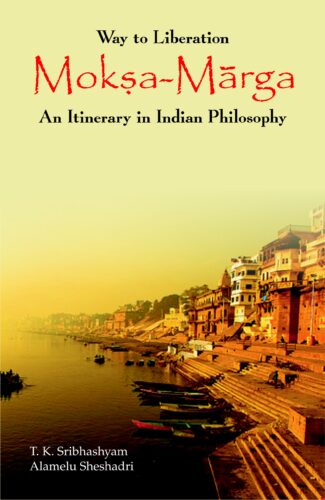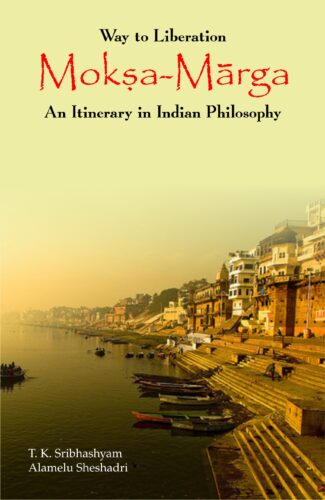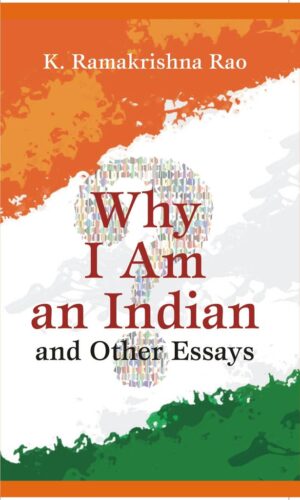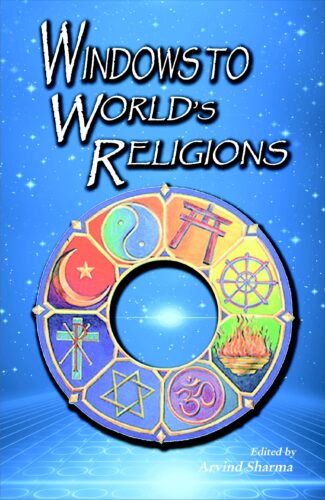Showing 1121–1130 of 1173 results

It is a comprehensive study of the defence policies, construction of forts, arms and ammunitions, commissariat, the espionage system, the rules of aggression and defence, the technical matters and war ethics, based upon a comparative study with the modern systems, and a thorough comprehension of Sanskrit, Sanskrit sources, and works like Silappadikaram, and Kural.
Differing from the existing studies on the warfare of ancient India; Warfare in Ancient India: In Historical Outline is a comprehensive study of the defence policies, construction of forts, arms and ammunitions, commissariat, the espionage system, the rules of aggression and defence, the technical matters and war ethics, based upon a thorough comprehension of Sanskrit and Sanskritic sources. This being done based on the existing and newly-explored sources. It also analyses the diplomatic and economic factors in aggressive designs, one of the major elements of the political history of early India.
This volume partially deals with the activities of the Indo-Aryans and their continuous struggle for survival against hostile environment in Indus Valley and their expansion towards the east along the major rivers of north India, leading to frequent invasions and attacks. Thus came the warlike traits of some major Vedic deities, ancient battles, arms and armour, chariots, forts, arrays, Jain war canons, and major weapons cited in the Mahabharata, Silappadikaram, Manasollasa, Kural, etc. as the main focus of the book. It also vividly addresses the war policies and tactics enunciated by Kautilya in Arthasastra and Manu in Manu-Smriti, and differentiations in their views on few aspects. The inevitable factors that led to wars survival, and domination and economic exploitation are also well dealt.
The book should enthuse the interests and spirit of all those who are into the study and research of history, warfare and ancient Indian culture mainly from the Vedic viewpoint.

The book projects light on concept of contemplation and meditation, including meditation techniques and practices, which is central to the attainment of moksha. It also explains meaning of love, devotion, religion, the body-soul relation and the three yogas understanding of which is essential to attain moksha.
The way to liberation or moksha needs perfect knowledge, perfect action and perfect surrender to the Lord. The bhakta becomes a bhagavata as he not only knows and sees but also lives as a servant of God. Moksha is the final approach to the purity and perfection of the human soul. This volume attempts an in-depth study of the concept of liberation or moksha and the way to attain it.
The book begins with the meaning of love, devotion, religion, the body-soul relation and the three yogas, an understanding of which is essential to understand the concept of moksha. In this context, it delves into the meaning of the Brahman, the Absolute, as conveyed in the Vedas and other religious works like the Upanishads and the Bhagavad-Gita, the concept of the universal spiritual entity of Sarveshvara, concepts of sin and virtue, and even the principles of monotheism and polytheism in Hinduism. Quoting from the scriptures and other relevant texts, it emphasises on the notion of devotion and its benefits to examine the means to self-realisation and liberation and includes a study of the concept of contemplation and meditation, including meditation techniques and practices, which is central to the attainment of moksha.
With interesting illustrations, the volume will be useful to religious scholars and students and seekers on the path of spiritual fulfilment.

The book projects light on concept of contemplation and meditation, including meditation techniques and practices, which is central to the attainment of moksha. It also explains meaning of love, devotion, religion, the body-soul relation and the three yogas understanding of which is essential to attain moksha.
The way to liberation or moksha needs perfect knowledge, perfect action and perfect surrender to the Lord. The bhakta becomes a bhagavata as he not only knows and sees but also lives as a servant of God. Moksha is the final approach to the purity and perfection of the human soul. This volume attempts an in-depth study of the concept of liberation or moksha and the way to attain it.
The book begins with the meaning of love, devotion, religion, the body-soul relation and the three yogas, an understanding of which is essential to understand the concept of moksha. In this context, it delves into the meaning of the Brahman, the Absolute, as conveyed in the Vedas and other religious works like the Upanishads and the Bhagavad-Gita, the concept of the universal spiritual entity of Sarveshvara, concepts of sin and virtue, and even the principles of monotheism and polytheism in Hinduism. Quoting from the scriptures and other relevant texts, it emphasises on the notion of devotion and its benefits to examine the means to self-realisation and liberation and includes a study of the concept of contemplation and meditation, including meditation techniques and practices, which is central to the attainment of moksha.
With interesting illustrations, the volume will be useful to religious scholars and students and seekers on the path of spiritual fulfilment.

The book projects light on concept of contemplation and meditation, including meditation techniques and practices, which is central to the attainment of moksha. It also explains meaning of love, devotion, religion, the body-soul relation and the three yogas understanding of which is essential to attain moksha.
The way to liberation or moksha needs perfect knowledge, perfect action and perfect surrender to the Lord. The bhakta becomes a bhagavata as he not only knows and sees but also lives as a servant of God. Moksha is the final approach to the purity and perfection of the human soul. This volume attempts an in-depth study of the concept of liberation or moksha and the way to attain it.
The book begins with the meaning of love, devotion, religion, the body-soul relation and the three yogas, an understanding of which is essential to understand the concept of moksha. In this context, it delves into the meaning of the Brahman, the Absolute, as conveyed in the Vedas and other religious works like the Upanishads and the Bhagavad-Gita, the concept of the universal spiritual entity of Sarveshvara, concepts of sin and virtue, and even the principles of monotheism and polytheism in Hinduism. Quoting from the scriptures and other relevant texts, it emphasises on the notion of devotion and its benefits to examine the means to self-realisation and liberation and includes a study of the concept of contemplation and meditation, including meditation techniques and practices, which is central to the attainment of moksha.
With interesting illustrations, the volume will be useful to religious scholars and students and seekers on the path of spiritual fulfilment.

How can we understand the Hindu tradition as alive today? That is the question which this book investigates. It asks for a broader understanding of history, rightful accounting of the Vedas and of other oral learnings. The goal of truth is sought by approaching different personalities and institutions of culture.
In India, there has long been a tendency to emphasize the spoken word which is passed on alive from an individual teacher to each individual student. But, through the development of modern media, more use is now made of the written word which records information externally, in institutions that have been industrially, socially and culturally organized. How then can we understand the Hindu tradition as alive today with its ancient emphasis upon the spoken word and the living individual? That is the question which this book investigates. Accordingly, it asks for a broader understanding of history, which would allow for a rightful accounting of the Vedas and of other oral learning. Through its continued emphasis upon the living word, the Hindu tradition asks for a deeper understanding of reasoned enquiry. Such reasons do not work primarily through mechanical instruments in the restricted way that modern physics does. Instead, it works essentially through a reflective investigation of our living faculties, which are thus cultivated and clarified. The goal of truth is not here sought through an institutional consensus; but rather as a common ground, which is approached quite differently through different personalities and institutions of culture.

How can we understand the Hindu tradition as alive today? That is the question which this book investigates. It asks for a broader understanding of history, rightful accounting of the Vedas and of other oral learnings. The goal of truth is sought by approaching different personalities and institutions of culture.
In India, there has long been a tendency to emphasize the spoken word which is passed on alive from an individual teacher to each individual student. But, through the development of modern media, more use is now made of the written word which records information externally, in institutions that have been industrially, socially and culturally organized. How then can we understand the Hindu tradition as alive today with its ancient emphasis upon the spoken word and the living individual? That is the question which this book investigates. Accordingly, it asks for a broader understanding of history, which would allow for a rightful accounting of the Vedas and of other oral learning. Through its continued emphasis upon the living word, the Hindu tradition asks for a deeper understanding of reasoned enquiry. Such reasons do not work primarily through mechanical instruments in the restricted way that modern physics does. Instead, it works essentially through a reflective investigation of our living faculties, which are thus cultivated and clarified. The goal of truth is not here sought through an institutional consensus; but rather as a common ground, which is approached quite differently through different personalities and institutions of culture.

Writing in a simple language, Prof. D. L. Johnson acquaints Asian readers with the traditional ideas and values that have shaped the culture of the western world over centuries, mainly dominant thinkers and ideas of classical Greece and Rome and religious traditions of the Jews and the Christians.
This book acquaints Asian readers with traditional ideas and values that have shaped the culture of the Western world over centuries. Written in simple language, it throws light on dominant thinkers and ideas of classical Greece and Rome as well as the religious traditions of Jews and Christians. Greek mythology, Greek epic literature and drama are included in the survey. The impact of Greek philosophy in moulding of Western thought as well as the Roman interpretations of Greek philosophy are included. The history of Jewish and Christian interpretations of god and the human predicament are explained with clarity and compared and contrasted with Asian ideas. Special attention is given to controversial ideas which often confuse Asian readers, as for instance the Jewish and Christian assertion of their ideas as truth claims. The book will be useful to scholars of Asia as well as to general readers and students keen on understanding the sources of Western culture and its appeal today.
Lord Buddha, in his profound wisdom, said that for extinction of human suffering, complete annihilation of desire is the only way. This is the sacred truth of suffering.
Acarya Carvaka, equally profound in his thinking, said that life is a continuous celebration of desire. Kama (desire) and artha (wealth) are the only true goals of life. Beg, steal or borrow, but live life like a king. Enjoy life full as long as one is alive.
Who is correct? Lord Buddha or Acarya Carvaka? What is desire really meant to Indian society, religion and culture through ages?
The book tries to address these and similar questions objectively and diligently.

This volume reflects the evolution and growth of Prof. K. Ramakrishna Raos thought and the different dimensions and shades of his academic pursuits, ranging from Gandhis thought to consciousness studies, educational issues, identity problems, parapsychology, and Indian psychology in general and yoga in particular.
This volume reflects the evolution and growth of Prof. K. Ramakrishna Raos thought and the different dimensions and shades of his academic pursuits, ranging from Gandhis thought to consciousness studies, educational issues, identity problems, parapsychology, and Indian psychology in general and yoga in particular.
While the topics covered appear to be very diverse and quite divergent, there is a common thread knitting them together; the thread is that the material covered is concerned with human nature. The crucial aspect of each of us is identity, which bestows on us individuality and separateness. It has its advantages and entails some problems as well. This book reflects on them from different perspectives, focusing mainly on the philosophical and psychological aspects in human functioning, and ones identity and unity with others.
Man is conceived as a composite of body, mind and consciousness. The discussion of these concepts hopefully sheds light directly or indirectly on the multiple problems concerning human nature and the associated difficulties in chasing them in real life and especially in ones academic pursuits.

A selection of papers presented at a global congress on World’s Religions after September 11, stressing the need for various religions to develop a better understanding of each other. The papers deal with Islamic, Christian, Bahai, Sikh, Primal and Hindu religious traditions and beliefs.
The volume is concerned with the role of religion in the present day. Presenting proceedings of a global Congress on Worlds Religions after September 11 held in September 2006 at Montreal, Canada, it stresses the need for interfaith friendships to develop understanding between faiths and remove stereotypes that have emerged concerning religious beliefs and their followers. Examining the thoughts of Western theologians and others on the role of religion, it discusses spirituality as being at the root of tolerance. The papers refer to Islamic, Christian Mennonite, Bahzi, Sikh and Hindu religious traditions and beliefs but bear specific reference to the North American Roman Catholic Retreat Centre at Pembroke, Ontario, Canada. They engage in examining specific topics pertaining to the different religious faiths and traditions. They examine the life of Guru Arjan Dev and his message and its significance today, the work of Mira Behn towards conserving the environment of the Himalayas, and the indigenous Australian Christian womens perception. The book provides a glimpse into the life, work and experiences of the spiritual women of Ramanashrama at Tiruvannamalai in Tamil Nadu and Ramanas views on womans right to spirituality, asceticism and salvation. It showcases the contribution of the Inter-religious Council of Central New York towards bringing people of different faiths and cultures into situations of mutual respect and trust. The volume includes the text of the Universal Declaration of Human Rights.
| There are no products |